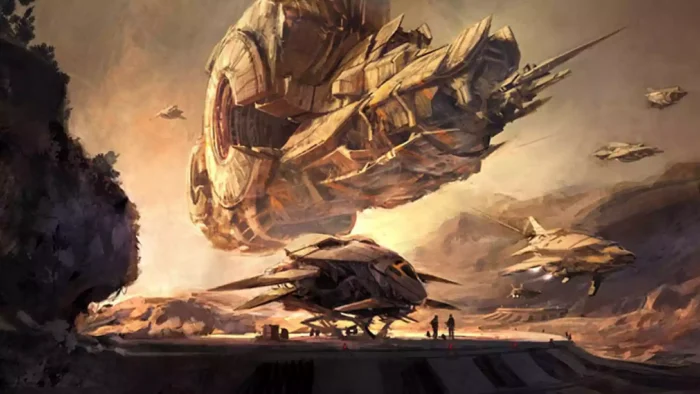Promising MMOs that were killed before final release
Let’s not kid ourselves: In the video game industry, it’s just part of everyday working life that projects are prematurely canceled while still in development. Most of the time, this happens very early, for example in the concept phase, and so early that we consumers don’t notice it at all. But every now and then something does get out, or it’s only shut down after the official announcement, which can be bitter for fans and developers alike.
The The genre of online role-playing games is quite susceptible to challenging development phases in this regard. The development of an MMO often takes many years and is correspondingly expensive. Some teams run out of money on the way to release. Sometimes, however, ideas that sound terrific on paper turn out to be less than entertaining in practice. Or a competitor comes to market earlier with a comparable idea. Or responsibilities change as a result of a takeover. New contracts are needed, but the companies involved cannot reach an agreement.
It is therefore not surprising that for every online role-playing game that has appeared in recent years, you can find three or four MMO projects that were killed while still in development. In this special, we look back at the most exciting titles. Everquest Next is there, of course, but also Titan, a World of Warcraft 2.0, a Lord of the Rings MMO, and a new Marvel license spin-off.
Titan: Blizzard’s MMO after WoW
Back in 2005, the year World of Warcraft was released in Europe, Blizzard executives revealed that they were already working on new games. A year later, they narrowed their plans down to three new projects. Today, we know that Diablo 3 and Starcraft 2 were among them, but the third game didn’t make news again until 2007, when the Blizzard homepage was looking for developers for a “next-generation online game”.
Then in August 2007, lead game designer Jeff Kaplan confirmed that Blizzard was working on a new MMORPG; in December of the same year, the developers specified that the project would not be the next WoW expansion. WoW community manager Jonathan “Zarhym” Brown went even further in May 2009 and revealed that they wanted to create a completely new brand with the game.
Titan comes to light
According to Chief Creative Officer Rob Pardo, the next official information about Titan was supposed to be available in 2011 at the earliest, but he didn’t count on Ye Weilun. The Blizzard manager was forced to resign shortly after a Chinese website leaked a table showing the release dates of Blizzard’s current projects. In addition to Starcraft 2, Diablo 3 and some milestones for WoW, the name Titan was also listed there for the fourth quarter of 2013 – the MMO project finally had a working title.
Despite the glitch, those responsible at Blizzard didn’t let their guard down. When Paul Sams told an editor of Gamasutra in an interview in March 2011 that they were already playing Titan and that the game was the most ambitious project they had ever worked on, it was quite astonishing, but also very vacuous. The same goes for Rob Pardo’s statement from September 2012 that over a hundred developers were currently working on Titan and that they had reached the middle of the development cycle. Even the artwork for Titan that appeared in the same month turned out to be just the finger paintings of a graphic artist from the Titan development team.
The rumor mill was bubbling
With their vow of silence, the Titan executives continued to fuel the mind games of the starving fans. Blizzard’s every move was closely watched and linked to the next-gen MMOG. For example, when the company licensed Procedural’s “Esri CityEngine” in September 2009, which allows players to create large cityscapes with just a few clicks, many talked about Titan becoming a second Second Life, a kind of online 3D infrastructure in which players could freely design the virtual world.
In April 2013, the author of the website titanfocus.info became even more concrete, circulating some exciting rumors that he is said to have received from an internal Blizzard source: According to them, the background of Titan is based on the history of Earth and is supposed to put a big emphasis on the myths of the Greeks, Romans and Vikings. The comparatively down-to-earth setting will be enriched with fictional elements like time travel and magic. The insider also revealed that Titan will have a very large esport focus and that the game will be controlled from the third-person view – just like WoW. Finally, he said that console versions are being considered, that 150 developers are currently working on Titan, and that the final name of the game has been decided.
In NFT MMO by Richard Garriott you can buy land in the realm of Lord British
A few weeks after the unconfirmed revelations on titanfocus.info, all the facts, rumors and mind games were worth nothing. The website Venturebeat reported in May 2013 that Blizzard had removed 70 employees from the Titan team to use them in other projects. A little later, Shon Damron confirmed the restructuring: “We’ve always taken a step-by-step approach to developing a game, and the unannounced MMO is no exception. We have reached a point where we need to make some major design and technical changes to the game. We’re taking the opportunity to reallocate some of our resources to help with other projects while the core team focuses on adapting the technology and tools to the changes.“
Time ticks inexorably
At this point, Blizzard was still known for preferring to abandon a project, even if it was almost finished, rather than put a half-baked game on the virtual and real store shelves. Just take the Warcraft adventure and Starcraft Ghost as cautionary examples.. They were equally known for taking their time, if necessary, until they were truly satisfied with all elements of the game. Time they didn’t have infinite when developing a next-generation online role-playing game.
When they started developing Titan in 2005, Facebook was still in its infancy, Free2Play was a swear word for Japanese sleep aids, and Second Life was the hottest shit on the net. The online world is spinning so fast that MMORPG developers need to have a very keen nose for future trends. Blizzard still had that with World of Warcraft: In 2005, the market and players were ripe for an accessible online role-playing game – thanks in part to the ever-increasing prevalence of Internet flat rates.
But WoW’s development period lasted a mere four to five years. After the reorientation, the release date for Titan was 2016, which means that development would take twice as long as for the first Blizzard MMORPG – and a lot could happen again in the next three years.
The fall of Titan
With the realignment, Blizzard admitted that they had reached a dead end with the path they had taken so far. A dead end that would first result in a restructuring and finally, in September 2014, in the discontinuation of the development of Titan. Game designer Jeff Kaplan later summed up the situation self-critically: “There was an incredible team working on Titan. All really talented people. But we failed horribly in every way … in every way that a project can fail. It was devastating.“
In an interview with Polygon, Chris Metzen stated, “We took a step back and realized that [Titan] had some cool hangers-on. It definitely had the value of a great idea, but it didn’t fit together.” For Blizzard, the concept of Titan simply didn’t feel coherent enough, so the developers eventually pulled the brakes. Blizzard’s goal is to make games that they love to play, that they love to love. It was precisely this passion that eventually got away from the Titan team. “We could not find the fun“, Mike Morhaime admitted in an interview with Polygon in 2014. “We talked about whether [Titan] is the game we want to make. The answer was no.” Chris Metzen added: “We wanted to try to do the right thing and build the right, patented product and keep it all moving.” Sometimes, he said, you have to take a step back as a successful team and regroup. Titan made it necessary for Blizzard to do just that.

The ruins of Titan eventually became the online shooter Overwatch.
Source: Blizzard
Kaplan’s team then turned to a new project to prove to themselves and everyone else that they were right to work at Blizzard: “Then, when development began on Overwatch, the team was extremely tight-knit, and everywhere you looked you could feel this hunger to prove to the world that we weren’t failures, but could create something that was incredibly fun.“, Kaplan said. And indeed, the online shooter was well received by gamers: Overwatch morphed into one of the best-selling titles ever after its release on May 24, 2016. By April 2021, 60 million players are expected to have played the online shooter. Many of the assets from Titan could be reused for Overwatch.
Follow us and check out our social media accounts on Twitter, Facebook & YouTube ►
● on Twitter ► esport.directory
● Facebook ► esport.directory
● Youtube ► esport.directory
WoW Classictips, WoW Classictricks, WoW Classiccheats, WoW Classichacks, WoW Classichacks2022, WoW Classictipspro, WoW Classicpaidcheats, WoW Classic, WoW Classictipsandtricks, WoW Classictipsandtricks2022, WoW Classictipsandtricksforbeginners, WoW Classictips, WoW Classictricks, WoW Classictrickshots, WoW Classichacks, WoW Classichacksfree, WoW Classichacksfree2022,




